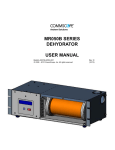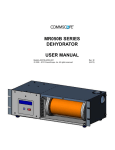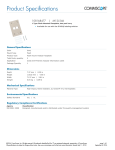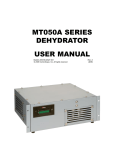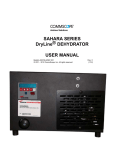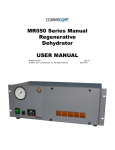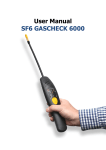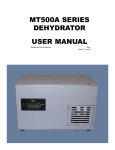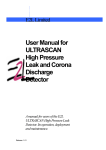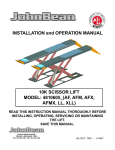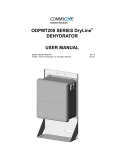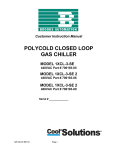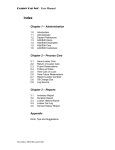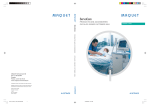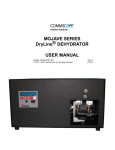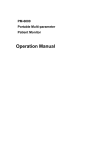Download MR050A SERIES DEHYDRATOR USER MANUAL
Transcript
MR050A SERIES DEHYDRATOR USER MANUAL Bulletin AE01B-A0532-001 Rev: B © 2008 - 2011CommScope, Inc. All rights reserved(04/11) MR050A SERIES DEHYDRATOR USER MANUAL SECTION 1 General Information Introduction Description Operation Alarms Option Multiple Alarm Option Specifications 3 3 3 3 3 4 5 SECTION 2Installation Unpacking and Inspection Controls and Displays Power Connections AC Power DC Power Connecting Low Pressure Alarm Output Connecting Dehydrator to the Transmission Line Purging the Transmission Line 6 6 6 7 7 7 8 8 9 SECTION 3Maintenance Maintenance Preventive Maintenance Desiccant Replacement Annual Maintenance Parts Replacement Service Restoration 9 9 9 9 9 9 10 SECTION 4Troubleshooting 11 Problem/Solution Table 11 Schematic Diagram MR050A-3101513 Alarm Schematic Diagram with All Option MR050A-3131515 Pneumatic Diagram16 SECTION 5 Replacement Parts 17 SECTION 6 Customer Service 17 Introduction17 In Case of Trouble 17 Initial Steps by CommScope 18 Return Goods Instructions 18 Repair Center Process 18 Loaner Units 18 Warranty 19 2 MR050A SERIES DEHYDRATOR USER MANUAL 1.1 Introduction This manual contains the information you need to install, operate, and maintain your MR050A Series DryLine® dehydrator. Please take the time to read this manual before attempting to operate or service the unit. 1.2 Description MR050A Series dehydrators provide dry air for pressurizing small (up to 280 liters, or 10 cubic feet, in volume) antenna and transmission line systems. The dehydrators produce -40ºC (-40ºF) dew point dry air at a nominal rate of 1.4 liters (0.05 cubic feet) per minute up to a total of 8495 Iiters (300 cubic feet) on a single desiccant canister. Each dehydrator consists of an electricallydriven air compressor, a desiccant canister, an automatic transmission line pressure sensing system, and alarm outputs housed in a rigid metal chassis. It is designed to mount directly to the rack, directly on a wall, or as a free-standing unit. The front panel features a control interface with display for alarms and pressure. For easy serviceability, power connections, alarm output connections, and the desiccant canister are easily accessible from the front of the unit. The MR050A maintains transmission line pressures between 2.0 and 3.4 kPa (0.3 and 0.5 psig). It is intended for use with high performance microwave antennas and earth station antennas. 1.3 Operation MR050A series dehydrators include a compressor, color indicating desiccant, high and low-pressure sensors, and a low-pressure alarm sensor. . 3 When system pressure falls to a preset low limit, the low-pressure sensor activates the compressor. Air is channeled through a desiccant canister, where moisture is adsorbed. The air exits the drying canister at -40°C (-40°F) dewpoint. It is then channeled directly to an internal 4-port manifold When system pressure reaches a preset high limit, the high-pressure sensor shuts off the compressor. A check valve prevents system dry air from retreating back through the compressor. If system pressure falls significantly below the low-pressure trigger point, the low-pressure alarm sensor will activate an alarm contact. This alarm is an indication of a significant system leak or a dehydrator failure. 1.4 Alarms The MR050A offers Low Pressure and Power Fail alarms as a standard feature. Alarm conditions are indicated on the display. Alarms are output as a common summary alarm, with a form C dry contact. The alarm is set for continuity on alarm. MR050A SERIES DEHYDRATOR USER MANUAL 1.4.1 Multiple Alarm Option Alarm Definitions: This optional assembly is designed to provide the additional High Humidity alarm to CommScope Dehydrators. All alarms are Form C dry contacts and are factory set for continuity at alarm (mains power fail alarm opens at alarm). Power Fail: Activates open when power is removed from the dehydrator. This includes turning the power off at the switch. High Humidity: Activates when system or dehydrator output humidity rise above 7.5% relative humidity. At initial installation, this alarm will continue to alarm until the system has been properly purged. Excess Run: Factory set run time is set in accordance with the normal run time for the dehydrator application. Selectable times are 30 minutes, with the 10 minute as default on the MR050A. Low Pressure: If system pressure falls below the low-pressure trigger point, the lowpressure alarm sensor will activate an alarm contact. This alarm is an indication of a significant system leak or a dehydrator failure. This optional assembly will also indicate discrete alarms on the display, and provide individual contacts and connections for discrete alarms. The external alarm monitoring system (supplied by others) is connected to the terminal strip located on the front of the cabinet. A small slotted screwdriver is necessary to make the connections. Changing Alarm Outputs: Multi Alarm Term. Summary Alarm Figure 1 Function Wire Color 1 Power Fail Com Black 2 Power Fail Alarm Red 3 Humidity Com Green 4 Humidity Alarm Brown 5 Excess Run Com Blue 6 Excess Run Alarm White 7 Low Press. Com Gray 8 Low Press. Alarm Orange 4 Alarm Factory setting Summary Alarm Normally Open (N.O.) Multiple Alarms Alarm Factory setting Where To Reset TB4 on Control Board Where To Reset Low Pressure Normally Open (N.O.) A-B Jumper JP4 on Alarm PCB Mains Normally (Power Fail) Closed (N.C.) B-C Jumper JP3 on Alarm PCB Excess Run Normally Open (N.O.) A-B Jumper JP1 on Alarm PCB High Humidity Normally Open (N.O.) A-B Jumper JP2 on Alarm PCB MR050A SERIES DEHYDRATOR USER MANUAL J1 Alarm to Control FUSE 5 amp, 250V JP1 Excess Run J P3 Power Fail J3 Alarm Connection J P4 Low Pressure JP2 High Humidity J5 HUM Bypass J4 Humidity Sensor J2 Main Power Figure 2 1.5 Specifications MR050A Dehydrator Cut Out Pressure 35 kPa (0.5 PSIG) Cut In Pressure 2 kPa (0.3 PSIG) Output capacity 85 SLPH (total, approx.) 1.4 SLPM (3.0 SCFH 0.05 SCFM) Output Dew Point, -36°C (-33°F) or better Operating Temperature Range 1° to +40° C (34° to +104° F) Low Pressure Alarm Output Connectors 3/8” polytube, compression Dimensions 450mm W x 132mm H x 216mm D (17.7” W x 5.2” H x 8.5” D) Weight 7.26 kg (16 lbs) Optional Alarms High Humidity Alarm 7.5% RH, factory set point 1.4 kPa (0.2 PSIG) Power Fail Alarm Loss of input power Electrical Input 24/48 Vdc 115/230 Vac, 50/60 Hz (with ac-to-dc adapter) Excess Run 30 minutes, factory set High Press Alarm 5.5 kPa (0.8 PSIG) Power Consumption 11 watts 5 MR050A SERIES DEHYDRATOR USER MANUAL Installation Section 2 2.1 Unpacking and Inspection Open Carton Remove the top piece of closed-cell foam packaging. Carefully remove the installation accessories, manual, and dehydrator. Check the dehydrator for shipping damage such as dents or loose parts. 2.2 Controls and Displays Familiarize yourself with the controls and displays prior to installing or testing the dehydrator. ON/OFF Switch Displays pressure and total run hours, flashes current condition. Mode 3: Displays last ON and last OFF times. Mode Switch ON/OFF Switch Toggles unit condition ON and OFF. Mode Switch Toggles between display modes. Mode 1: Mode 2: Displays pressure and total run hours. 6 MR050A SERIES DEHYDRATOR USER MANUAL 2.3 Installing the Dehydrator 2.3.1 19” Rack Mounting or set on shelf 2.4 Power Connections Confirm your dehydrator electrical input matches the available power. CAUTION: Check the antenna and transmission line system pressure rating before connecting the dehydrator to the system. White stripe wire: + 24 Vdc/48 Vdc MR050A-31015 MR050A-31315 2.4.1 AC Power AC units can be connected into a standard 15 Amp power receptacle of the proper voltage via the power supply. Make sure the power circuit is properly grounded. Two power cords are supplied, one 115 VAC American and one 230 VAC International. Blue Tube Low Pressure FUSE 5 amp, 250V TB4 Alarm Board TB1 PIN 1 – DC – PIN 2 – 24 V JUMPER PIN 3 – DC MOTOR B PIN 4 – DC + PIN 5 – 24 V JUMPER PIN 6 – DC MOTOR TB3 Summary Alarm 7 MR050A SERIES DEHYDRATOR USER MANUAL Test the Dehydrator Note: Turn the dehydrator ON and check the output port on the rear of the unit to make sure air is flowing. If the transmission lines have not been purged, continue with section 2.7. Otherwise proceed to section 3. 2.5 Connecting the Alarm Outputs 2.7 Purging the Transmission Line To connect the alarms, locate the alarm output terminal block on the front of the unit. Optional alarms (if purchased) will also be located on this terminal (see section 1.4 for terminal numbers). Air in the transmission line system must be replaced with dry air to ensure satisfactory operation of the transmitted signal. 2.6 Connecting Dehydrator to the Transmission Line Insert one end of the 3/8” polytube feed line tubing into the compression fitting on one of the dehydrator output ports. Tighten securely with a 9/16” wrench. Be careful not to over tighten. Connect the other end of the polytube to the transmission line. Multi Alarm Summary Alarm 8 1. Determine the total system volume. 2. Divide the system volume by the flow rate of the dehydrator (3.0 SCFH) to determine the number of hours needed for the purge cycle. 3. Open the far end of the transmission line. 4. Operate the dehydrator for three purge cycles. If it is not possible to open the far end of the transmission line, follow these steps: 1. Connect the dehydrator to the transmission line and pressurize the system. The system pressure should reach 0.5 PSIG. 2. Wait 15 minutes while the air absorbs moisture in the system, then disconnect the dehydrator from the transmission line and allow the air to vent. 3. Repeat steps 1 and 2 twelve times to purge the system. MR050A SERIES DEHYDRATOR USER MANUAL Maintenance Section 3 3.0 Maintenance The MR050A Dehydrator requires relatively little maintenance to ensure satisfactory operation over long periods of time. This section outlines the recommended annual preventive maintenance for the unit and the suggested overhaul for every 6000 hours of compressor operation. 3.1 Preventive Maintenance The annual maintenance of a MR050A consists of a preventative maintenance inspection of the dehydrator. These tasks can easily be performed in the field with the unit connected to the transmission line system. In addition to the annual inspection, a complete overhaul is recommended every 6000 hours or sooner if local conditions warrant. 3.2 Desiccant Replacement As the desiccant becomes saturated over time, it will change from blue to pink. When the desiccant is exhausted, there will be a degradation of performance. In order to replace the desiccant, simply turn the unit off, disconnect the desiccant canister from the pneumatic lines, and replace the entire canister. 3.3 Annual Inspection Inspection includes checking for loose or damaged hoses, fittings, and electrical connections. Remove the desiccant canister and verify that there are no leaks in the pneumatic lines. Warning: Electrical Hazard! Unplug power cord before servicing unit. 9 Check the electrical connections. Check the screw at the power input connector to ensure that the AC power cord is securely terminated. Check the screw-in alarm terminals to ensure that all wire connections are tight. A loose or damaged connection may result in erratic operation and unnecessary downtime. Refer to the troubleshooting section if an electrical problem is encountered. Check the ground wire. Check that an electrical safety ground is installed on the stud on the rear of the dehydrator. This connection point is adjacent to the power input connector. (It is intended to be customer installed in the field.) Check the hour meter on the front panel to determine the duty cycle of the dehydrator. If the dehydrator has been running for more than 10% of its installed time, check the systems for leaks. 3.4 Parts Replacement When the MR050A dehydrator unit is in need of service, the main components are simply replaced. The compressor, desiccant canister, and control module are all meant to be replaceable parts. The parts can be purchased from CommScope for field replacement, or the unit can be sent to the repair center for component replacement. MR050A SERIES DEHYDRATOR USER MANUAL Unit Shutdown and Removal In order to perform an overhaul on the MR050A, the unit must be turned off and removed from service. As this is being done, the low pressure alarm may activate through a reporting alarm system. Personnel monitoring such an alarm should be notified in advance so that they are aware of the fact that service is being performed. It is also necessary to disconnect the dehydrator dry air output from the waveguide system during the overhaul. Remove the chassis top and front panels for overhaul. 1. Unplug the unit from the power supply. 2 Follow the instructions included in the compressor replacement kit. When the replacement is complete, reinstall. 3.5 Service Restoration RECOMMENDATION: If the dehydrator overhaul process has taken more than a few hours, it is recommended that the unit be run for one hour into the room, to purge the membrane dryer and tank of any acquired moisture, before reconnecting to the transmission line system. 10 MR050A SERIES DEHYDRATOR USER MANUAL Troubleshooting Section 4 If you experience difficulty with your dehydrator, use the troubleshooting procedures described below. Caution: Electrical troubleshooting requires access to potentially dangerous voltages and should only be performed by a licensed electrician Problem/Condition Solution If the display light fails to light, make sure the unit is plugged in and power outlet is operating. Dehydrator display does not light, unit does not run. If you still have no light, unplug the unit, remove the unit cover and check for loose connections. Refer to the wiringdiagram for proper connections. Check to assure that the fuse is OK. Check to assure that proper AC voltage is being supplied to the input. Plug the unit output with finger and observe pressure gauge. The pressure gauge line should read approximately 0.5 psi and the alarm should clear. If alarm does not clear, remove cover and verify tubing and wiring connections are secure. Low-pressure alarm activated. If the pressure does not remain constant after plugging the output, apply leak detector to isolate the leak in the dehydrator (exercise care when applying solution not to wet wiring or electronics). With dehydrator isolated from transmission line, observe pressure in transmission line. If pressure drops, use a leakdetector solution to locate leaks in the transmission line. Repair leaks if possible. If the problem persists contact CommScope Customer Service. Compressor does not turn OFF. Check the display on the controller. Toggle the ON/OFF switch (left of the display). Check input power polarity and voltage per wiring diagram. 11 Notes MR050A SERIES DEHYDRATOR USER MANUAL 12 COMPRESSOR 13 WHITE TB1 TB3 U9 BLACK WHITE TB4 MR050A-31015 Wiring Diagram BLACK BLACK FUSE 5 amp, 250 V PIN 1 IS BLANK. POWER STRIP - BLACK + WHITE SUMMARY ALARM GRAY ORANGE MR050A SERIES DEHYDRATOR USER MANUAL Notes MR050A SERIES DEHYDRATOR USER MANUAL 14 15 POWER FAIL, BLACK LOW PRESS ALARM, ORANGE LOW PRESS COM, GREY EXCESS RUN ALARM, WHITE EXCESS RUN COM, BLUE HUMIDITY, BROWN HUMIDITY COM, GREEN POWER FAIL ALARM, RED FULL ALARM COMPRESSOR RED J5 J1 HUMIDITY SENSOR GREEN TB3 TB4 J4 J2 BLACK WHITE FUSE 5 amp, 250 V U9 MR050A-31315 Wiring Diagram BLACK TB1 BLACK WHITE BLACK FUSE 5 amp, 250 V POWER STRIP BLACK RED GREEN BLANK + WHITE - BLACK MR050A SERIES DEHYDRATOR USER MANUAL 16 Manifold Sub-assembly 1/4" Hose 5" Long -31315 Only 1/4" Hose 8" Hose -31315 Only Humidity Sensor Sub-assembly Pneumatic Diagram Control Module -31315 Only 1/4" Hose 11.5" Hose -31015 Only 1/4" Hose 7.5" Long Compressor 1/4" Hose 5" Long 1/4" Hose 15" Long 1/4" Hose 7.5" Long Desiccant Canister MR050A SERIES DEHYDRATOR USER MANUAL MR050A SERIES DEHYDRATOR USER MANUAL Replacement Parts Section 5 Customer Service Section 6 Check website for latest updates to the manaul and parts lists. 6.0 Introduction CommScope provides in-warranty and outof-warranty repairs as well as dehydrator and compressor overhauls from several Repair Centers. Coordination of these services is provided through the nearest Sales Office or Customer Service Center. The Center is also prepared to help you with the following: Technical Assistance Troubleshooting Repairs Loaner Units Spare Parts Installation Materials System Accessories. 6.1 In Case of Trouble The first step you should take if trouble develops using a dehydrator is to read the operators manual and follow the trouble isolating procedures given in it. If the steps in the manual do not identify and remedy the problem, then contact an CommScope Customer Service Center for 24hour telephone assistance. Record the Model Number (e.g. MR050A) and Serial Number from the product label, as you will be asked for these when you call. Two main locations are currently available to help: in North America --- 1-800-255-1479 in Europe --- +44 1592 782612 any Location (to USA) (708) 349-3300 If you find it easier to describe your troubles by Fax, then the following numbers are also available: in North America ---1-800-349-5444 (Fax only) in Europe --- +44 1592 782380 (Fax only) any Location (to USA) (708) 349-5410 (Fax only) The following is a list of the replacement kits for the MR050A Series dehydrators: Desiccant Kit MR050A-KIT-DSCNT Compressor Kit MR050A-KIT-CPRSR CommScope 3 Westbrook Corporate Center, Suite 900 Westchester, IL 60154 USA Controller Kit MR050A-KIT-CNTLR 17 MR050A SERIES DEHYDRATOR USER MANUAL 6.2 Initial Steps by CommScope When your call or fax communication is received, the CommScope staff will work with you to pinpoint the possible cause of trouble. If the pressurization equipment is suspect, they will: dehydrator. 6.4 Repair Center Process The CommScope Dehydrator Repair Center will receive your unit and inspect it for any transport damage. The unit will then be analyzed for troubles using the description you have supplied and the specialized experience the Repair Center staff have with dehydrators. • ask for your unit Model Number and Serial Number • check the warranty status of the unit • advise the availability of a loaner unit provide of the cost for inspection and repairs, if the unit is out-of-warranty If the unit is in-warranty, repairs are made at no charge and the unit will be returned to you by the same mode of transport as it was received. If the unit is in-warranty, but no problems are found, the unit will be thoroughly tested before being returned to you. A nominal inspection fee will be charged for this service. If your unit is out-of-warranty, it will be inspected and repaired for the quoted fee. 6.5 Loaner Units The CommScope dehydrator Repair Centers stock a limited number of “loaner” dehydrator units of both current and discontinued products. These units, while not new, are still in excellent working order. Loaners are available on a first-come firstserved basis. They are issued in conjunction with the original RGN and are invoiced at a nominal price. You will need to request a second RGN to return the loaner unit. A credit memo is issued by the Repair Center when a loaner is returned • fax a Return Goods Authorization Sheet to you. 6.3 Return Goods Instructions After you have contacted CommScope and received a Return Goods Authorization Number (RGN), you will need to take the following steps to send the faulty unit to a Repair Center: • make a copy of the Return Goods Authorization Sheet that was faxed to you • write a brief description of the trouble you are encountering and attach this to the copy of the sheet • pack the unit (with at least 4-inches of protective packaging on all sides) • enclose the authorization sheet and trouble description within the box • enclose a purchase order or other method of payment for non warranty repairs. • mark the outside of the box with the RGN • return the box to the Repair Center address listed on the authorization sheet. If you have saved the original packaging that came with the unit, use it to return the dehydrator for repair. If a loaner unit (of the same type) was supplied by CommScope, use the loaner unit box to return the original 18 MR050A SERIES DEHYDRATOR USER MANUAL 19 MR050A SERIES DEHYDRATOR USER MANUAL 20




















